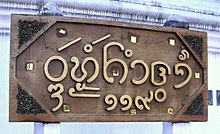Lanna (font)
The Lanna script (also Tai-Tham, Dhamma / Dharma or North Thai script; northern Thai : ᨲ᩠ᩅᩫᨾᩮᩬᩥᨦ, dai tam or tua müang ; Thai: อักษร ธรรม ล้าน นา , Lao : ອັກ ສອນ ທໍາ ລ້ານ ນາ , akson tham Lanna , "Lanna- Dharma - Script ”) is an Abugida that was used in the time of the northern Thai kingdom of Lan Na for the writing of the language of the same name . Today, however, the Lanna language (also called Northern Thai) is mainly passed on orally or written in the Thai script .
The related Tai languages Tai Lü (mainly spoken in southern China) and Khün (in Myanmar) are written with very similar scripts - in some cases to this day.
The script is a derivative of the Brahmi script and has corresponding properties: All consonants have an inherent vowel -a, the vowel can be changed using vowel symbols. However, the Lanna script has many more vowel characters than its neighboring script systems. Similar to the Khmer script , consecutive consonants are placed one below the other. Lanna also includes consonant signs, which are used in some cases, and tone signs to change the tone.
The name 'Tai Tham' or Dhamma script comes from the fact that the writing system was mainly used to record religious texts. The alphabet is very similar to the Shan script .
history
From around the middle of the 14th century, the Tai Yuan in Lan Na used two scripts for different purposes: For secular use in their own language, a script derived from Sukhothai's Proto-Thai script; for religious texts that were written in Pali , however, they adopted the Mon script of the time . The latter was therefore called Tua Tham , ie “Dhamma writing”. Later, however, it also became established for secular use and thus became the commonly used script Lan Nas, which was called Tua Müang ("local letters").
Due to the cultural leadership role of Lan Nas during its heyday in the 15th century, the script was also adopted by the Tai Lü in Sipsong Panna (now the People's Republic of China) and the Tai Khün in Keng Tung (now Myanmar), who were culturally closely linked to Lan Na . In Lan Xang (today's Laos and northeastern Thailand ) a very similar script was used, but only for religious texts. The common script was an important link for the areas and cultures in which it was used. The Thaiist Hans Penth therefore spoke of the "cultural region of Dhamma writing". The traditional (secular) Tai-Yuan alphabet was only used for inscriptions and official and diplomatic documents and fell completely out of use in the second half of the 19th century. The modern (central) Thai script took its place. The Lanna script, on the other hand, was used well into the 20th century, especially in a religious context.

As part of the national unification ( Thaiization ), the Thai government under Prime Minister Phibunsongkhram outlawed the use of the Lanna script for the spelling of the northern Thai dialects from 1939. However, their distribution actually only decreased from the 1950s. Nowadays, only a small minority of the people of northern Thailand can read the Lanna script. The Lanna language is mainly used in informal, oral communication. In written use, however, it was pushed back by the central Thai standard language (and its writing). However, efforts have been made to revive the local script since around the 1990s. In northern Thailand, lettering in this alphabet is again often used to emphasize a regional cultural identity.
Among the Tai Lü in the southern Chinese province of Yunnan , the Lanna script was largely replaced by the simplified New Tai Lü script developed in the 1950s . This has also found widespread use among the Tai Lü who live outside of China.
See also
literature
- Harald Hundius : Phonology and script of the northern Thai (= treatises for the knowledge of the Orient. 48, 3). Steiner-Verlag Wiesbaden, Stuttgart 1990, ISBN 3-515-04845-6 .
Web links
- Lanna alphabet (Tua Mueang)
- Digital Library of Northern Thai Manuscripts - Project of the Cultural Preservation Program of the Foreign Office in Thailand
Individual evidence
- ^ PJ Bee, I. Brown, Patricia Herbert, Manas Chitakasem: Thailand. In: South-East Asia. Languages and Literatures: a select guide. University of Hawaii Press, Honolulu 1989, p. 28.
- ^ A b Hans Penth: A Brief History of Lan Na. Civilizations of North Thailand. 2nd edition, Silkworm Books, Chiang Mai 2000, p. 41.
- ↑ a b c Penth: A Brief History of Lan Na. 2000, p. 43.
- ↑ Akiko Iijima: The Nyuan in Xayabury and Cross-Border Links to Nan. In: Contesting Visions of the Lao Past. Laos Historiography at the Crossroads. NIAS Press, Copenhagen 2003, p. 179 (fn. 25); Carol Stratton: Buddhist Sculpture of Northern Thailand. Silkworm Books, Chiang Mai 2004, p. 14.
- ^ Volker Grabowsky : Brief history of Thailand. CH Beck, Munich 2010, ISBN 978-3-406-60129-3 , p. 158.
- ^ Anthony Diller: Tai Languages. Varieties and Subgroup Terms. In: Thai-Yunnan Project Newsletter , No. 25, 1994, pp. 8-17, at pp. 11-12.
- ^ Mette Halskov Hansen: Lessons in Being Chinese. Minority Education and Ethnic Identity in Southwest China. University of Washington Press, Seattle 1999, p. 88.
- ^ Jean Michaud: Historical Dictionary of the Peoples of the Southeast Asian Massif. Scarecrow Press, Lanham MD / Oxford 2006, pp. 146–147, keyword Lue .

